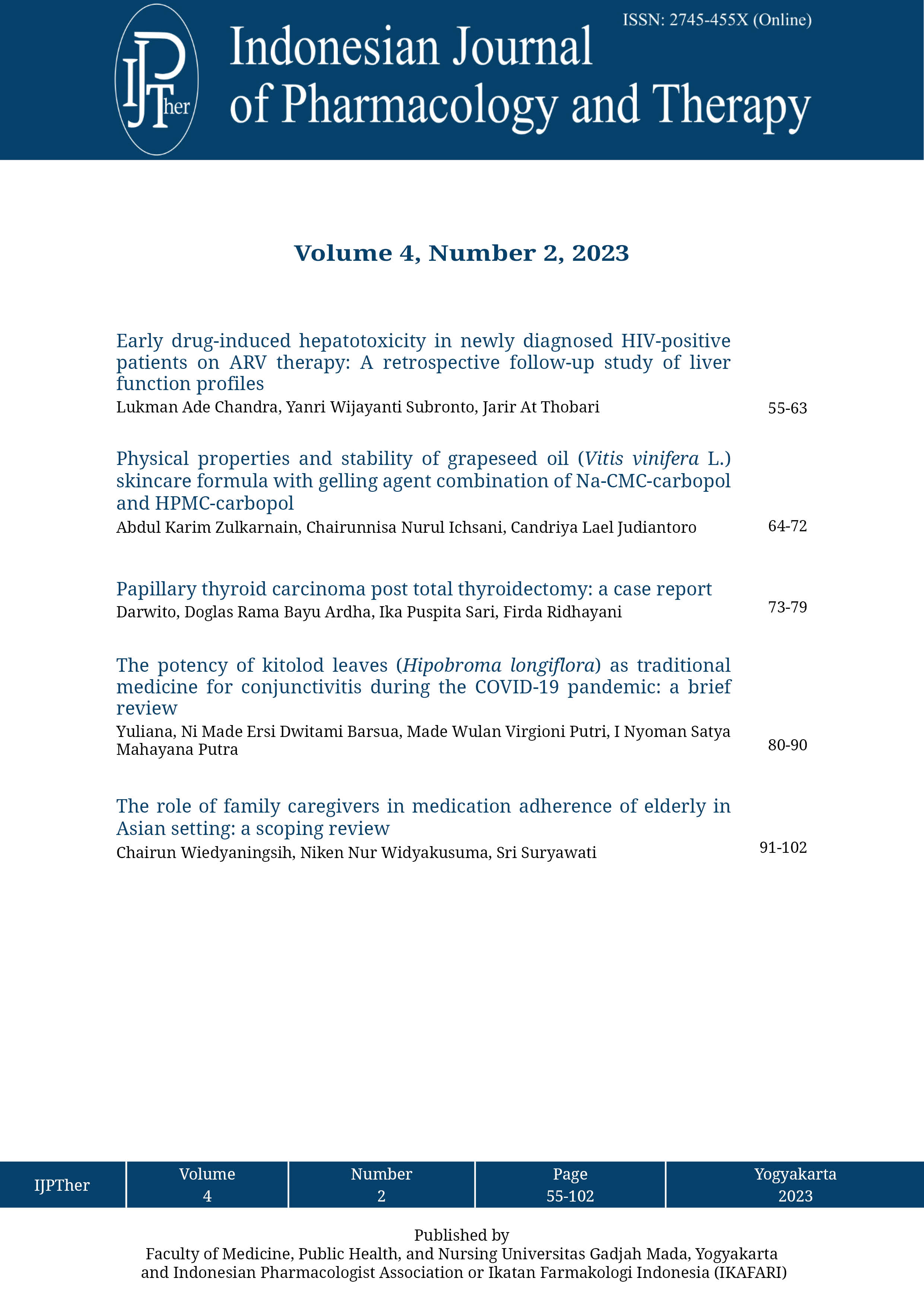Early drug-induced hepatotoxicity in newly diagnosed HIV-positive patients on ARV therapy: A retrospective follow-up study of liver function profiles
Abstract
Antiretroviral therapy (ART) is a primary therapeutic modality for managing individuals with Human Immunodeficiency Virus (HIV) infection, and its efficacy has been established. However, the safety profiles of ART need to be continually monitored, including early elevated liver function test (LFT) after antiretroviral (ARV) initiation. This study aimed to assess the incidence of abnormal LFT among HIV-positive patients receiving initial ARV and to identify factors associated with abnormal LFT. A retrospective cohort study without a control group summarised medical records from Dr Sardjito General Hospital, Yogyakarta between January 2014 and December 2021. The study subjects were adult HIV patients taking their first ARV and underwent follow-up visits for at least two weeks. Study outcomes were LFT levels, abnormal LFT, and factors associated with abnormal LFT during follow-up visits at 2 wk, 6 mo, and 12 mo. Univariate and multivariate analyses will be performed with a significance level of p<0.05. A total of 137 subjects with 203 visits were retrieved from medical records. The subjects' mean age was 33.4 years, predominantly male, younger, unmarried, in the early stage of HIV infection, and without comorbidities. The findings showed a significant increase in alanine transaminase (ALT) at all three follow-up visits: 2 wk (p=0.02), 6 mo (p=0.003), 12 mo (p=0.001) and an increase in aspartate aminotransferase (AST) after 6 mo (p=0.007) and 12 mo (p=0.04). Abnormal LFT levels (AST and/or ALT) were observed in 23.4% of patients after a normal baseline, with ALT increase being more common. Furthermore, homosexuality was identified as a significant independent factor associated with abnormal LFT (AOR=3.1; 95% CI 1.27-7.51; p=0.01). The findings indicate exceptionally elevated LFT levels and the occurrence of abnormal LFTs among HIV-positive patients initiating ARVs. The increase in abnormal LFTs was significantly associated with patients identifying as homosexual, where hepatitis co-infection may be a contributing factor. The limited study design and measured variables warrant further investigation.
References
List of Approved HIV Antiretroviral Drugs [Internet]. verywellhealth. 2022 [cited April 17, 2023]. Available from: https://www.verywellhealth.com/list-of-approved-hiv-antiretroviral-drugs-49309.
Hammer SM, Squires KE, Hughes MD, Grimes JM, Demeter LM, Currier JS, et al. A controlled trial of two nucleoside analogues plus indinavir in persons with human immunodeficiency virus infection and CD4 cell counts of 200 per cubic millimeter or less. New England Journal of Medicine. 1997;337(11):725-33.
David S, Hamilton JP. Drug-induced liver injury. US gastroenterology & hepatology review. 2010;6:73.
Núñez M. Hepatotoxicity of antiretrovirals: incidence, mechanisms and management. Journal of hepatology. 2006;44:S132-S9.
Gebremicael G, Tola HH, Gebreegziaxier A, Kassa D. Incidence of hepatotoxicity and factors associated during highly active antiretroviral therapy in people living with HIV in Ethiopia: a prospective cohort study. HIV/AIDS-Research and Palliative Care. 2021:329-36.
Sterling RK, Chiu S, Snider K, Nixon D. The prevalence and risk factors for abnormal liver enzymes in HIV-positive patients without hepatitis B or C co-infections. Digestive diseases and sciences. 2008;53:1375-82.
Martínez E, Blanco JL, Arnaiz JA, Pérez-Cuevas JB, Mocroft A, Cruceta A, et al. Hepatotoxicity in HIV-1-infected patients receiving nevirapine-containing antiretroviral therapy. Aids. 2001;15(10):1261-8.
Zimmerman HJ. Hepatotoxicity: the adverse effects of drugs and other chemicals on the liver. 1999.
Navarro VJ, Senior JR. Drug-related hepatotoxicity. New England Journal of Medicine. 2006;354(7):731-9.
Alghamdi S, Alrbiaan A, Alaraj A, Alhuraiji A, Alghamdi M, Alrajhi A. Elevated alanine aminotransferase levels in HIV-infected persons without hepatitis B or C virus co-infection. Annals of Saudi medicine. 2016;36(4):288-91.
Nagu T, Kanyangarara M, Hawkins C, Hertmark E, Chalamila G, Spiegelman D, et al. Elevated alanine aminotransferase in antiretroviral‐naïve HIV‐infected African patients: magnitude and risk factors. HIV medicine. 2012;13(9):541-8.
Moya-Salazar J, Barrial-Vega M, Arrieta-Calderón R, Contreras-Pulache H. Changes in liver function test levels in HIV patients undergoing highly active antiretroviral therapy (HAART). Longitudinal study in Lima, Peru. Revista de la Facultad de Medicina. 2022;70(1).
Audsley J, Seaberg EC, Sasadeusz J, Matthews GV, Avihingsanon A, Ruxrungtham K, et al. Factors associated with elevated ALT in an international HIV/HBV co-infected cohort on long-term HAART. PloS one. 2011;6(11):e26482.
Liu S, Zhou Y, Wang Y, Li CB, Wang W, Lu X, et al. The Correlated Risk Factors for Severe Liver Damage Among HIV-Positive Inpatients With Abnormal Liver Tests. Frontiers in medicine. 2022;9:817370.
Dieterich DT, Robinson PA, Love J, Stern JO. Drug-induced liver injury associated with the use of nonnucleoside reverse-transcriptase inhibitors. Clinical Infectious Diseases. 2004;38(Supplement_2):S80-S9.
Sulkowski MS. Drug-induced liver injury associated with antiretroviral therapy that includes HIV-1 protease inhibitors. Clinical Infectious Diseases. 2004;38(Supplement_2):S90-S7.



